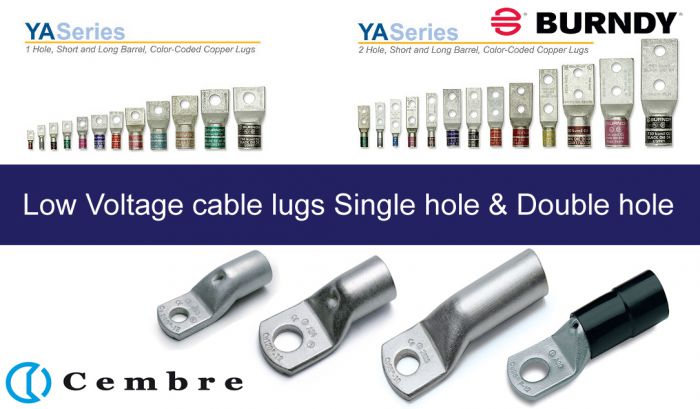LV CABLE LUGS LV (Low Voltage) cable lugs play a crucial role in electrical installations, providing a secure and reliable connection between cables and electrical equipment. Whether you’re an electrician, engineer, or a DIY enthusiast, understanding the different types of LV cable lugs, their installation methods, and best practices is essential for ensuring a safe and efficient electrical system. In this blog post, we will explore LV cable lugs in detail, providing you with valuable insights and practical tips.
Table of Contents:
What are LV Cable Lugs?
Types of LV Cable Lugs
a. Crimped Cable Lugs
b. Soldered Cable Lugs
c. Mechanical Cable Lugs
Selecting the Right LV Cable Lug
Installation Steps
a. Preparation
b. Stripping and Preparing the Cable
c. Crimping or Soldering the Lug
d. Insulation and Sealing
Best Practices for LV Cable Lug Installation
a. Proper Cable Sizing
b. Quality Assurance
c. Torqueing and Crimping Standards
d. Environmental Considerations
Common Mistakes to Avoid
Maintenance and Inspection
Compliance with Standards and Regulations
Conclusion
What are LV Cable Lugs?
LV cable lugs are metallic connectors used to terminate and connect low voltage cables to electrical equipment such as switchboards, distribution panels, and motors. They provide a reliable electrical connection and ensure efficient power transmission between cables and devices.
Types of LV Cable Lugs:
a. Crimped Cable Lugs: These lugs are designed to be crimped onto the cable using dedicated crimping tools. They are available in various sizes and configurations to accommodate different cable sizes and termination requirements.
b. Soldered Cable Lugs: Soldered cable lugs are attached to cables by soldering the lug barrel to the cable conductor. This type of connection offers excellent conductivity and mechanical strength.
c. Mechanical Cable Lugs: Mechanical cable lugs rely on mechanical compression to establish a secure connection. They often feature a bolt or screw mechanism to clamp the cable conductor.
Selecting the Right LV Cable Lug:
Choosing the appropriate cable lug depends on factors such as cable size, conductor material, current rating, and environmental conditions. It’s crucial to consult the manufacturer’s specifications and guidelines or seek professional advice to ensure compatibility and compliance.
Installation Steps:
a. Preparation: Gather the necessary tools and equipment, and ensure safety measures are in place. Familiarize yourself with the lug’s design and instructions provided by the manufacturer.
b. Stripping and Preparing the Cable: Strip the cable insulation to expose the conductor, ensuring the proper length according to lug specifications. Remove any corrosion or contaminants from the conductor.
c. Crimping or Soldering the Lug: Follow the manufacturer’s instructions for crimping or soldering the lug to the conductor. Use appropriate crimping tools or soldering techniques, ensuring a reliable and durable connection.
d. Insulation and Sealing: Insulate the connection using heat shrink tubing or insulation tape to protect against electrical shock, moisture, and physical damage. Ensure proper sealing and strain relief to maintain the integrity of the connection.
Best Practices for LV Cable Lug Installation:
a. Proper Cable Sizing: Select the cable lug and cable size based on the current rating and load requirements. Undersized lugs or cables can lead to overheating and voltage drop.
b. Quality Assurance: Use high-quality cable lugs from reputable manufacturers to ensure reliability and compliance with standards. Inspect the lugs for any defects or damage before installation.
c. Torqueing and Crimping Standards: Follow the recommended torque values and crimping standards specified by the manufacturer to achieve the desired electrical and mechanical performance.
d. Environmental Considerations: Consider the environmental conditions, such as temperature, moisture, and chemical exposure, and choose lugs with appropriate insulation and corrosion resistance properties.
Common Mistakes to Avoid:
Incorrect lug selection or sizing
Insufficient cable preparation
Inadequate crimping or soldering techniques
Poor insulation and sealing practices
Neglecting proper torqueing or over-torqueing
Ignoring safety precautions
Maintenance and Inspection:
Regularly inspect LV cable lugs for signs of damage, corrosion, or loose connections. Perform preventive maintenance and re-torque connections if necessary. Follow the manufacturer’s recommendations for maintenance and inspection intervals.
Compliance with Standards and Regulations:
Ensure that your LV cable lug installation adheres to relevant electrical standards, codes, and regulations. Familiarize yourself with local requirements and consult with certified professionals when necessary.
Conclusion:
are integral components of electrical systems, providing secure and efficient connections. By understanding the different types of lugs,their installation procedures, and following best practices, you can ensure a reliable and safe electrical installation. Always prioritize safety, quality, and compliance with standards when working with . If in doubt, consult professionals or manufacturers for guidance.




